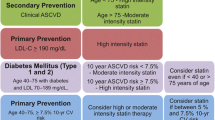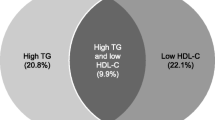Abstract
Purpose of Review
An examination of the current ACC/AHA and ESC/EAS Guidelines on the management of dyslipidemias for common ground and differences.
Recent Findings
There is much common ground. Both note that ASCVD is, in most people, the product of a number of risk factors, notably tobacco exposure, hyperlipidemia, hypertension, inactivity, overweight and diabetes. They stress that risk calculators can help in the assessment of risk in apparently healthy persons. Persons with established ASCVD and many with diabetes or renal impairment are at high to very high risk and warrant intensive risk factor advice. The ACC/AHA Guidelines favor the universal use of statins in all high-risk subjects. In contrast, the ESC/EAS Guidelines favor a goal approach based on total risk and baseline LDL cholesterol level.
Summary
Perhaps the most important challenges are to stress similarities rather than differences and to simplify communications with both healthcare professionals and the public. Subjects with established vascular disease and renal impairment and many with diabetes are at high to very high risk and need intensive risk factor management. A risk chart or calculator is recommended to assess total risk in apparently healthy persons. The higher the risk, the more intense the risk factor management.






Similar content being viewed by others
References
Papers of particular interest, published recently, have been highlighted as: • Of importance •• Of major importance
•• Stone NJ, Robinson JG, Lichtenstein AH, et al. 2013 ACC/AHA guideline on the treatment of blood cholesterol to reduce atherosclerotic cardiovascular risk in adults: a report of the American College of Cardiology/American Heart Association Task Force on Practice Guidelines. Circulation. 2013;129:S1–45. Primary source of this review
•• Catapano AL, Graham I, De Backer G, et al. 2016 ESC/EAS guidelines for the management of dyslipidaemias. Eur Heart J. 2016;37:2999–3058. The second primary source of this review
•• Piepoli MF, Hoes AW, Agewall S, et al. 2016 European Guidelines on cardiovascular disease prevention in clinical practice: the sixth joint task force of the European Society of Cardiology and Other Societies on Cardiovascular Disease Prevention in Clinical Practice (constituted by representatives of 10 societies and by invited experts): Developed with the special contribution of the European Association for Cardiovascular Prevention & Rehabilitation (EACPR). Eur Heart J. 2016;37:2315–81. These joint guidelines are complementary to the ESC/EAS Guidelines for the management of dyslipidemias and deal with all aspects of prevention of ASCVD
• Ray KK, Kastelein JJ, Boekholdt SM, et al. The ACC/AHA 2013 guideline on the treatment of blood cholesterol to reduce atherosclerotic cardiovascular disease risk in adults: the good the bad and the uncertain: a comparison with ESC/EAS guidelines for the management of dyslipidaemias 2011. Eur Heart J. 2014;35:960–8. Helpful review but deals with the 2011 ESC/EAS Guidelines rather than the 2016 ones
• Giner-Galvan V, Esteban-Giner MJ, Pallares-Carratala V. Overview of guidelines for the management of dyslipidemia: EU perspectives. Vasc Health Risk Manag. 2016;12:357–69. Comprehensive review
Lee JC, Zdrojewski T, Pencina MJ, et al. Population effect of differences in cholesterol guidelines in Eastern Europe and the United States. JAMA Cardiol. 2016;1:700–7.
Eckel RH, Jakicic JM, Ard JD, et al. 2013 AHA/ACC guideline on lifestyle management to reduce cardiovascular risk: a report of the American College of Cardiology/American Heart Association Task Force on Practice Guidelines. Circulation. 2014;129:S76–99.
Goff Jr DC, Lloyd-Jones DM, Bennett G, et al. 2013 ACC/AHA guideline on the assessment of cardiovascular risk: a report of the American College of Cardiology/American Heart Association Task Force on Practice Guidelines. Circulation. 2014;129:S49–73.
Jensen MD, Ryan DH, Apovian CM, et al. 2013 AHA/ACC/TOS guideline for the management of overweight and obesity in adults: a report of the American College of Cardiology/American Heart Association Task Force on Practice Guidelines and the Obesity Society. Circulation. 2014;129:S102–38.
Grundy SM, Cleeman JI, Merz CN, et al. Implications of recent clinical trials for the National Cholesterol Education Program Adult Treatment Panel III guidelines. Circulation. 2004;110:227–39.
Goff Jr DC, Lloyd-Jones DM, Bennett G, et al. 2013 ACC/AHA guideline on the assessment of cardiovascular risk: a report of the American College of Cardiology/American Heart Association Task Force on Practice Guidelines. Circulation. 2013;129:S49–73.
Ridker PM, Cook NR. Statins: new American guidelines for prevention of cardiovascular disease. Lancet. 2013;382:1762–5.
Conroy RM, Pyorala K, Fitzgerald AP, et al. Estimation of ten-year risk of fatal cardiovascular disease in Europe: the SCORE project. Eur Heart J. 2003;24:987–1003.
Cooney MT, Vartiainen E, Laatikainen T, et al. Cardiovascular risk age: concepts and practicalities. Heart. 2012;98:941–6.
• Robinson JG. Lower might be better—it matters how you get there, and in whom. Eur Heart J 2016; 37:1380–1383. Thoughtful commentary on the ACC/AHA Guidelines 1.
EAS (2013) Comment by the EAS Guidelines Committee. New guidelines in USA: 2013 ACC/AHA Guidelines on the treatment of blood cholesterol to reduce atherosclerotic cardiovascular risk: how do they compare with the EAS/ESC guidelines for the management of dyslipidaemia? Available: http://www.eas-society.org/Newsletter-Archive.aspx?newsId=316.
Ioannidis JP. More than a billion people taking statins? Potential implications of the new cardiovascular guidelines. JAMA. 2014;311:463–4.
Statins for millions more? Lancet 2014; 383:669.
Keaney Jr JF, Curfman GD, Jarcho JA. A pragmatic view of the new cholesterol treatment guidelines. N Engl J Med. 2014;370:275–8.
Mihaylova B, Emberson J, Blackwell L, et al. The effects of lowering LDL cholesterol with statin therapy in people at low risk of vascular disease: meta-analysis of individual data from 27 randomised trials. Lancet. 2012;380:581–90.
Boekholdt SM, Hovingh GK, Mora S, et al. Very low levels of atherogenic lipoproteins and the risk for cardiovascular events: a meta-analysis of statin trials. J Am Coll Cardiol. 2014;64:485–94.
Mortensen EM, Nordestgaard BG, Afzal S, et al. ACC/AHA guidelines superior to ESC/EAS guidelines for primary prevention with statins in non-diabetic Europeans: the Copenhagen General Population Study. Eur Heart J 2016.
Blazing MA, Giugliano RP, Cannon CP, et al. Evaluating cardiovascular event reduction with ezetimibe as an adjunct to simvastatin in 18,144 patients after acute coronary syndromes: final baseline characteristics of the IMPROVE-IT study population. Am Heart J 2014; 168:205–212 e1.
Acknowledgments
The authors wish to thank Dr. Angela Pirillo for editorial help.
Author information
Authors and Affiliations
Corresponding author
Ethics declarations
Conflict of Interest
Ian M. Graham has received speaker fees confined to talks on the content of the Guidelines and on risk estimation from Merck Sharpe and Dohme and Pfizer.
Alberico L. Catapano has received honoraria, lecture fees, or research grants from Sigma-Tau, Menarini, Kowa, Eli Lilly, Recordati, Pfizer, Sanofi, Mediolanum, Merck, Aegerion, Amgen, Genzyme, Bayer and AstraZeneca.
Human and Animal Rights and Informed Consent
This article does not contain any studies with human or animal subjects performed by either of the authors.
Additional information
This article is part of the Topical Collection on Lipid Abnormalities and Cardiovascular Prevention
Rights and permissions
About this article
Cite this article
Graham, I.M., Catapano, A.L. Management of Dyslipidemias in Europe and the USA: Same Evidence, Different Conclusions? Can We Find Common Ground?. Curr Cardiol Rep 19, 49 (2017). https://doi.org/10.1007/s11886-017-0857-7
Published:
DOI: https://doi.org/10.1007/s11886-017-0857-7




